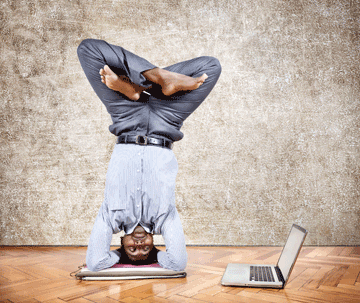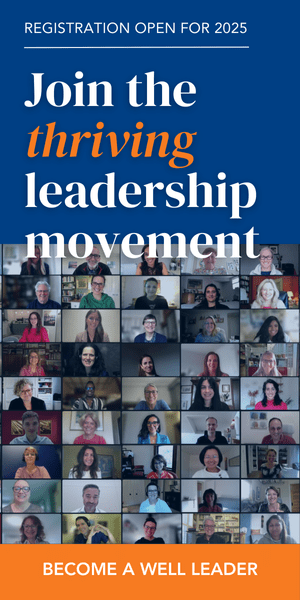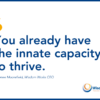 Right before entering my workplace, a blinking button signals me to press “yes” or “no.” Employees voluntarily decide, and I choose “yes” because my trust in the company is high. It’s the year 2020 and unlike the negative perceptions held about business in 2013—when companies seemed more interested in operating for their sake rather than delivering value for the sake of wellbeing—companies today realize that, no matter how it’s measured, business success is fueled by human energy. In fact, inspiring and channeling human energy for positive impact has become a primary purpose for existing as a company at all.
Right before entering my workplace, a blinking button signals me to press “yes” or “no.” Employees voluntarily decide, and I choose “yes” because my trust in the company is high. It’s the year 2020 and unlike the negative perceptions held about business in 2013—when companies seemed more interested in operating for their sake rather than delivering value for the sake of wellbeing—companies today realize that, no matter how it’s measured, business success is fueled by human energy. In fact, inspiring and channeling human energy for positive impact has become a primary purpose for existing as a company at all.
But back to that flashing button. When I press “yes,” a human energy scanner built into the doorway instantaneously captures a wide range of physiological biometrics to create a snapshot of my personal wellbeing. For instance, it evaluates my stress level based on my breathing rate, heart rate variability, and brain waves, and by checking my blood sugar, it knows whether I may need a snack mid-morning to keep my mind focused. A nanosecond later, these biometrics show up on my handheld device (the only device I ever need these days), along with four personalized suggestions for managing my energy based on the work I need to accomplish. I give the suggestions a quick glance, and say “yes, yes, yes, no”; it’s my choice how best to manage myself. My answers immediately populate my schedule.
I review the first suggestion: “To bring your best creativity to your 9:00am strategic planning conversation with Javier, consider holding the meeting outside. The weather will be pleasant, approximately 70oF. While there, gaze into the sun for a few seconds to stimulate your pineal gland, which helps to regulate your sleep-wake cycle, fight seasonal affective disorder, and open up enlightened insights.” Makes sense to me.
I notice that each suggestion factors in at least three things:
- The biometrics of my current energy level.
- My calendar of activities for the day (which I categorized online yesterday by the type of skills required for each task, i.e. visionary thinking, focused concentration, balanced decision-making, etc.)
- Things I easily can do on my own using resources nearby.
In this way, I’m better able to bring my best self to the task at hand, no matter what I’m doing or where I am, in every aspect of my life.
I’ve had good results with past suggestions the energy scanner has given, too:
- Walk in the office gardens during a potentially difficult conversation with a colleague. Nature nurtures, and walking side-by-side can help people see a situation from a shared point of view.
- Do a 5-minute appreciation meditation before a presentation to a major client. Not only will it create more efficient and harmonious functioning between your cardiovascular, hormonal, nervous, and immune systems, it also will support your sense of calm and coherence with the client.
- Perform a Headstand pose or press the GB 14 (the spot about an inch above each eye) acupressure points for 5 minutes to increase your clarity of mind and energy level when rallying the team for the sales meeting.
- Infuse your car with the aroma of sandalwood to rebalance yourself so that you’re fully present for your life partner and kids when you get home.
Looking around my 2020 workplace, I see how far we’ve come from less than a decade ago to support wellbeing at work. Nowadays we draw from the latest science and ancient wisdom to identify the most effective and personal ways to manage energy and boost productivity at a fraction of what it used to cost. Wellbeing tools are accessible and easy to use.
What’s really changed since 2014? Our beliefs about wellbeing at work. Today we know that the best work—and workplaces—contribute to, rather than deplete, human energy. We recognize that human energy is central to being human and to being successful on a personal and corporate level. Now, excuse me while I join my team in our twice-weekly Krav Maga practice!
Read More:
– The forgotten factor in leadership







Renee, As usual I am filled with pride when I read the words that you have written. They never fail to slap me in the face and say Hey, why haven’t you thought of this before. I am so very proud of you.
Bravo Renee, it is a wonderful vision for the future!
This future can become a reality when leaders embrace their individual power to influence culture within a company. These personal choices by leaders will can create a seismic shift within a company.
I read somewhere that megatrends are big shifts caused by millions of personal choices.
Heres to the 2020 vision!
Clare
I completely agree, Clare. I believe that “millions of personal choices” now being made by employees, consumers and citizens are fueling a wellbeing movement globally. Leaders of all kinds – whether as formal roles or as social change agents – have a clear opportunity not only to respond to this wellbeing movement with their business and social practices, but also contribute to it with how they lead in every moment. They can bring a more attuned, balanced and wiser form of leading to every decision and action.
And with that kind of leadership, the 2020 vision of a workplace which nourishes human energy – and thus is more effectively powered by it – isn’t far away at all. It is truly an exciting time to witness the wellbeing movement underway!
Renne
You have seen through the vail of tomorrow and this vision may not be as far away as 2020. Our cars have all of the tools for a machine that your describe for a human. Why wait? This can be the best approach for aging in place for people who are trying to figure out if they need exercise or meditation or drugs, eat more or less, etc. And imagine if this approach is available in schools and universities.
Keep dreaming, thinking and doing. Change is happening everyday.
Thanks for sharing.
Steve
Thanks, Steve. Your vision for Serenbe (www.serenbe.com) is a perfect opportunity to experiment with these kinds of innovations in human wellbeing!